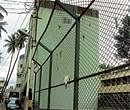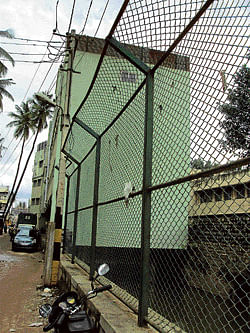

Just 17 months are left to complete the remodelling which began in 2007. The work is limping while the money has been going down the drain.
The work on cleaning and strengthening of storm water drains (SWDs) under the Centrally-sponsored programme JnNURM is among several mega projects of the City which are languishing owing to poor planning and tardy execution.
The Centre has approved the cost of remodelling of primary and secondary drains leading to the four major valleys - Hebbal, Vrushabhavati, Koramangala and Challaghatta - at a total cost of Rs 643.06 crore. The money spent, according the records of the nodal agency, Karnataka Urban Infrastructure Development and Finance Corporation (Kuidfc) is Rs 372.24 crore.
The implementing agency, Bruhat Bangalore Mahanagara Palike (BBMP), has spent Rs 372 crore till the end of July 30. This paper accessed the information under the Right to Information Act from the Kuidfc. The records says desilting, laying chain link fencing and construction of retaining wall of the drains have been completed in stretches where there is room to take up the work.
The Palike officials, furnishing details under the RTI to this paper, stated that 14,19,033.34 cubic metres of silt had been removed spending Rs 129.84 crore.
The funds are meant for desilting, remodelling, erecting metal chain link fence along the drains and constructing retaining walls. Name any of these works and nothing has been done satisfactorily to justify the expenditure of crores of rupees.
Deccan Herald found during visits to the valleys that the drains have not been declogged as huge masses of silt deposits continue and of course, stench continues to emanate. In many places the fence is broken, facilitating easy dumping of municipal waste and debris in the drain. Encroachment of areas adjoining the drains and dumping of waste along the drains are a common sight.
The surface of water flowing in Vrushabhavathi valley, passing through Bapuji Nagar on Mysore Road, is covered with municipal waste. Similar is the scene at the Koramangala-Challaghatta valley passing through Shanti Nagar. The stench wherever the the drains pass through is unbearable because, the SWDs carry both rain water and sewerage. In many drains, the sewerage pipes are embedded in the SWDs.
Bangaloreans’ apathy too is to blame for the clogged SWDs. Unmindful of the consequences, people dump waste and debris in the drains. The people residing near the drains, in the absence of sewerage pipes, are letting out sewage directly into the rain water drains.
The worst culprits are solid waste management contractors. They have been found using the vacant space available along and close to the drains as dumping yards. During the rains, the wastes turn into silt and obstruct the flow of water.
Drains, during the rainy season, often overflow because of the encroachment of the drains itself. The encroachers include both the greedy urban rich and the roofless poor.
While the rich are found putting up commercial establishments right on top of the drain or on the sides adjoining the drains, the poor have constructed their pigeon-hole dwellings adjacent to the retaining walls of the drains.
A huge commercial complex, located on Lal Bagh road, is constructed on pillars that go deep into the drain. The complex houses a lodge, an apparel shop and offices of private firms. The building owner has escaped the axe of the BBMP despite the head office of the Palike being a stone’s-throw away from the complex.
900 Illegal buildings
It is not that the BBMP is unaware of such illegal buildings. It has already identified buildings that have come up on the drains. Devaraj, Chief Engineer (SWD) of the Palike said about 900 buildings on the drains have been identified for demolition. Surprisingly, even after commencing the revamping of the drains three years ago, the Palike is still at the planning stage when it comes to bulldozing the illegal structures, some of which are obstacles to the free flow of water in the drains.
Asked about the measures taken by the Palike to avoid over-flow of drains in the rainy season, Devaraj said the works on the SWD has been stopped temporarily as the revised details project report (DPR) was being prepared.
“There is no fresh allocation of funds. The works will begin after the allocation of funds from the council,” the Chief Engineer said.
Lack of planning
More than the funds, it is the planning which is lacking. The Palike had prepared a plan for remodelling the SWDs even before JnNURM came into existence. When the government learnt about the availability of funds under the JnNURM, the plan it had on hand was poised for funding. In many places, let alone rebuild the drains, there is no place even to move excavators to remove the silt.
Designing of SWDs should be in such a way that it should be wider at the place where it lets out water to a valley than at the place of origin because as the drain progresses more and more water gets collected. But it is not so in case of the existing SWDs. Even if the Palike decides to widen the drains, it is very difficult because the land along the drains have structures. As per the norm, at least 50 mts from the drains should have no structures.
Unless elected representatives show strong will power to remove encroachments, remodelling of the SWDs, in toto, will remain in files, officials in the Kuidfc, who did not like to be named, said.
The Bangalore Water Supply and Sewarage Board has approved a multi-crore sewerage pipe replacement plan. But with no land available to lay pipes, the Board may find it tough to implement its plan. If only rain water flows in SWDs, then the water could be collected for reuse.
Deaths in drains
Storm water drains serve many purposes except for what they are meant - free flow of rain water. It is not unusual to see people slipping into the drains and dying.
Following is a list of deaths caused due to over-flowing drains since 2007, the year in which the drains remodelling began.
* April 21, 2007: Subbalakshmi (45) drowned in Ulsoor
* May 31, 2009: Abhishek (6) drowned Lingarajapuram
* Sept 16, 2009: 18 months old Vijay Kumar drowned near Madivala lake
* May 15, 2010: Ramakrishna (48) washed away in a drain in Hosakerehalli
No review so far
The BBMP’s way of functioning is something unbelievable. It proposed an old plan for remodelling the SWDs to JnNURM in 2007 and got it approved. Later, it continued to deviate from the plan as it added new works. Karnataka Urban Infrastructure Development & Finance Corporation (Kuidfc), the nodal agency of JnNURM works in the State, has directed the Palike to prepare a revised DPR.
On top of it, the remodelling work has not been reviewed in the last three years, by the Independent Review and Monitoring Agency (IMRA), set up under the JnNURM. The revised DPR should include changes to be made till September 2010 and later it would be submitted to IMRA.
Expenditure
Valley Approved cost So far spent*
Hebbal valley - Rs 184.74 crore Rs 105.47 crore
Vrushabhavati Rs 228.26 crore Rs 165.25 crore
Koramangala Rs 111.49 crore Rs 59.50 crore
Challghatta Rs 118.57 crore Rs 42.02 crore
Total funds approved under JnNURM – Rs 643.06 crore
Funds spent so far – Rs 372.24 crore
* As on July 31, 2010
(This article is written under a Fellowship of CSE, New Delhi)